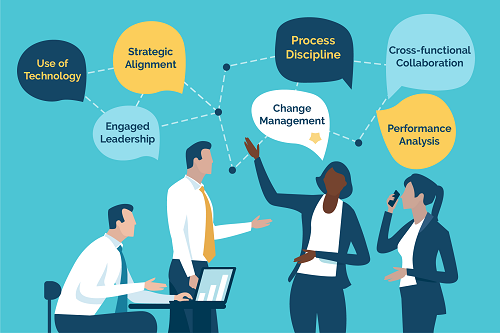 I reconnected with a former client and learned that his team struggled with executing their strategy. Although they crafted a good strategy, they faltered in translating ideas into action. Effective leadership requires teams to skillfully assess, adapt, and enhance strategy execution for lasting success. This demands specific capabilities within organizations to facilitate a thorough strategy review process. In this blog, I’ll outline the seven key essential capabilities.
I reconnected with a former client and learned that his team struggled with executing their strategy. Although they crafted a good strategy, they faltered in translating ideas into action. Effective leadership requires teams to skillfully assess, adapt, and enhance strategy execution for lasting success. This demands specific capabilities within organizations to facilitate a thorough strategy review process. In this blog, I’ll outline the seven key essential capabilities.
Process Discipline
To a certain extent, most organizations that are struggling with execution lack process discipline. Teams that execute well maintain cultures of continuous learning, leverage well-defined performance measurement or OKR frameworks, impose a regular meeting cadence that suits your organization’s needs, and think in terms of systematic problem solving over finger pointing and individual heroics. A regular and disciplined process prevents strategies from becoming stagnant and enables timely adjustments.
Engaged Leadership
It is essential for leadership to drive the strategy review cycle process. Leaders should actively participate, be willing to adapt to new strategies as needed, and prioritize the process over firefighting. This engagement communicates to the team that this is important.
Cross-functional Collaboration
Most strategy teams have by now gotten the message that strategy formulation should be a cross-functional conversation. But not all of them realize that execution benefits from the same approach. Cross-functional collaboration is crucial for getting diverse perspectives, insights, and expertise. It is also key to help teams get a more holistic understanding of the impact of their strategies.
Strategic Alignment
Strategic Alignment efforts don’t step after the cascading workshops end. For a strategy review cycle to be effective, there must be a constant effort to reinforce alignment between the strategies and initiatives being reviewed and the overarching goals and strategies of the organization. It is also important to constantly review and adapt strategic objectives depending on changes in the strategic situation. Constantly reinforcing alignment will confirm a sense of purpose and meaning to the work of the organization.
Performance Analysis
Nothing is more frustrating than attending a review session where no one understands the information being presented. Organizations that are good at strategy execution have the right skills to collect, analyze, and interpret data related to KPIs and other measures. Leadership teams should always be working to improve the art and science of data-driven decision making.
Use of Technology
Strategy review meetings are far more satisfying when the right technology is used to support the discussion. Performance dashboards, data visualization platforms, and collaboration tools streamline the review process and enable a far more engaging experience.
Change Management
Some clients think about change management during the planning process but then forget about it later. Principles such as clear communications, engaging key stakeholders regularly, fostering a culture of teamwork and accountability can ensure that the organization is better equipped to pivot when needed without too much disruption.
Conclusion
The effectiveness of your strategy review process can make or break your strategy execution success. By building out the capabilities above, strategy teams can ensure that their strategy review meetings are useful and drive the organization towards the breakthrough results that envisioned in the planning sessions.
To learn more about the strategy review process, consider our Balanced Scorecard Professional or Strategy Execution Certification Programs. If you need support for your review process, contact us about our Strategy Review Facilitation advisory services.
David Wilsey is the Chief Executive Officer with the Balanced Scorecard Institute and co-author of The Institute Way: Simplify Strategic Planning and Management with the Balanced Scorecard.

